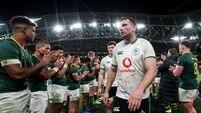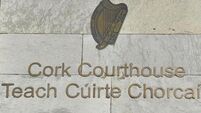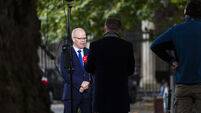‘Good beds, good wifi and good coffee’: The secrets to keeping Irish players happy in Japan

Manoeuvring a 55-person touring party and more than 10 tonnes of equipment around Japan for a month-and-a-half through half a dozen transfers is not many people’s idea of time well spent but Ger Carmody would not have it any other way.
As the IRFU Head of Operations, Carmody was the person in charge of planning the nuts and bolts of Ireland’s World Cup campaign on the other side of the world and now Joe Schmidt and his squad are in-country, it is his job to keep them on schedule and in the right place for every minute of their days.
This is Carmody’s fifth Rugby World Cup and his expertise and experience in the operational side of managing a rugby tour is such that he has also performed the same role on two tours with the British & Irish Lions.
So breaking new ground with a first World Cup in Asia has not fazed him one bit, quite the opposite.
“I love it,” Carmody told the Irish Examiner. “I don’t think I’d be here this long if I didn’t enjoy it.
“And what a great place it is to be, in the middle of a World Cup with the best players in our country and what a great staff to be working with. I couldn’t think of anything better to do. I feel really privileged to be part of it and I love it.”
The scale of the operation has changed “considerably” since he embarked on his first World Cup operation to Australia in 2003.
“The number of people involved has changed, the management team was just 12 in 2003. From what I did then to what I do now is vastly different in the organisation and how detailed it is, it’s just grown and grown and grown in terms of professionalism. It’s the same for every team but that’s the expectation. The Lions was a big learning curve for me as I got to visit the other three countries involved and see how they worked and what they did, which was a unique experience. And the scale of a Lions tour is another step up from this in terms of numbers and people and kit and freight.”
Japan 2019 is not exactly a day trip to the seaside either. Carmody has been planning for this tournament since the first of three reconnaissance missions here in October 2017, when he, head coach Schmidt and head of strength and conditioning Jason Cowman visited Japan to assess Ireland’s hotel and training ground options.
“The draw had been made, so we knew the cities we would be going to. We couldn’t see the match venues but we could look at the different options about where to stay and train.
“Your choices are guided by the ranking so as the top-ranked team in the pool at the time of the draw we pretty much got what we wanted.
“Rugby World Cup package up the hotel, training pitch, indoor hall and gym, so it’s not like you can stay in one hotel and choose a different pitch.
“You have to work around that which is different to what you normally plan, choose a hotel you’re happy with, then choose a pitch and so on.
“Ultimately what we want to try and do, is break up our hotel choices into a working hotel for when you’re more focused on training and gym work than you are necessarily on maybe more R and R for the boys. So the working hotels tend to be a bit further out of the city centres and then into city centres where the lads have a little bit more time and things to do. Primarily you want to make sure you’re not on buses for too long.
“So on the first recce, we looked at all our options and selected our hotel and training packages.
A return visit in the autumn of 2018 ratified those decisions from the first exploration and enabled Carmody to visit the match venues for the first time.
“In normal situations, the home team obviously gets the first choice of dressing room. At a World Cup, it’s a coin toss to decide and if you’re Team A you get first choice of everything, changing room, coaches’ box, warm-up area when you arrive. If you’re Team B you take what’s left. So we were Team A for Scotland, we’ll be A for Russia and Samoa but we’re Team B for Japan.”
The third and final recce last April saw Sinead Bennett from Team Services and nutritionist Ruth Wood-Martin get into the real detail with hotel staff.
“It’s important to start building relationships with people you’re going to work with at the hotels and we want to make sure we have that communication pathway and they understand what our expectations are. We really need to make sure the players have a good night’s sleep, good beds to sleep in, good wifi and good coffee. If we get those things right we’re halfway there.
“Japan isn’t necessarily a country used to dealing with rugby players, the volume of food they’re going to eat and so on, and some of the things we detected quite early on was the length of some of the beds were small, the shower heights were low - you wouldn’t have got a tall player into the shower in one of the hotels we viewed. You need to have an eye for these things, ask yourself, ‘would that work?’ In some of the hotels, it would not have worked.
“Some of the most challenging things we’ve found are some of the distances involved. Some of the match venues are up to an hour-plus away (from team hotels) and that’s not the norm for teams to travel. When we first came here, there wasn’t any familiarity with dealing with rugby players so the Japanese people had to learn to understand rugby. The layout of hotels and how things were allocated wasn’t how we’d allocate them, for instance, but to be fair, a huge amount of work has gone since day one to where we are today and all our expectations have been met. The operational delivery of the tournament has been fantastic and you couldn’t fault anything they’ve done.
“There isn’t a huge amount
of difference between England 2015 and here other than some of the cultural differences and them learning some of the expectations of rugby teams which was across the board. I don’t think we as Ireland were looking for anything that anybody else wasn’t.”
There is a lot to take in and plan for while with a 55-strong tour party plus two RWC liaison officers, two security personnel and an interpreter to move around Japan across the pool stages and hopefully beyond, there also needs to be structure.
“There’s a detailed itinerary every day. It’s a little bit like being in boarding school, it maps out your life for you and tells you when to go, where to be and what to wear. It’s pretty organised and we all get used to that very quickly when we’re in camp.
“It’s a little bit strange when you go home and you don’t get a sheet telling you what to do for the day.”



















